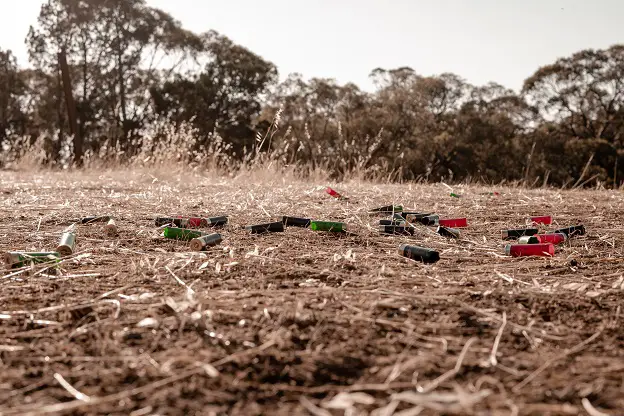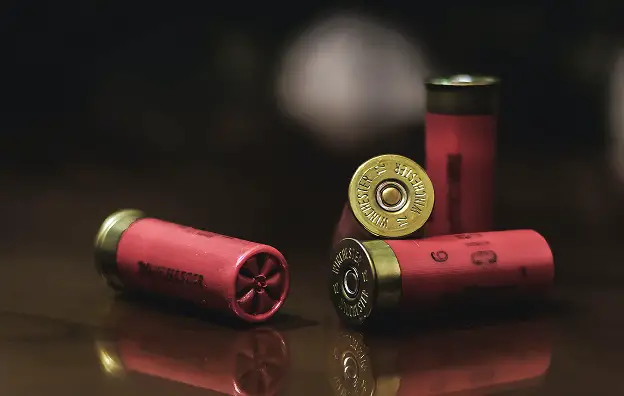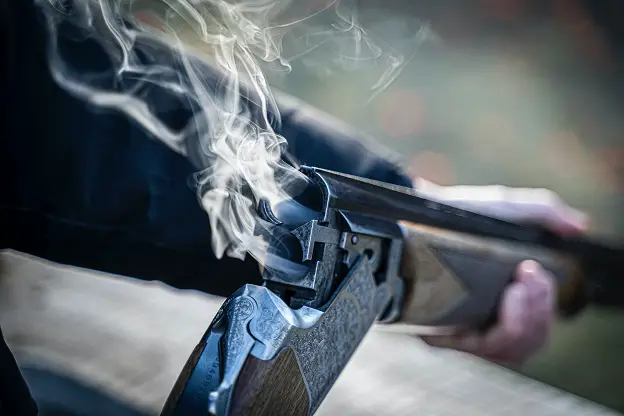A 12-gauge shotgun loaded with birdshot is a good choice for most home defense situations. It creates a shallow, but wide wound channel with sure lethality at 20 feet. If you have children in the home, you won’t have to worry about over penetration because birdshot will not exit a body.
With a proper understanding of how birdshot functions at close ranges, you can decide if and when it’s a viable option for you.

Birdshot for Home Defense
Birdshot is the most widely available ammunition in the US. it’s generally used for shooting clays or small game hunting but certainly has a defensive application. the payload of a 12 gauge shotgun with birdshot is one ounce of lead pellets, going 1275 fps, and hitting with a force of 2,000 ft/lbs.
Birdshot has been traditionally, very effectively used in close-range defensive situations. The shotgun was long feared across the world for its insane stopping power at close range. It’s also cheap and easy to come by in the US. Birdshot comes in a lot of different sizes, and they all work.
The most common shot sizes for defensive use are between #4 and #8. That’s because they are the commonly available small game and target shooting sizes. generally, the bigger pellets (smaller number) are more effective, but the smaller sizes will work just fine at home defense distances. We’re talking pretty close here, almost any size will work.
If it gives you any reassurance, I have a shotgun as my home defense weapon. turns out it’s my best option for home defense, for reasons I’ll discuss below.
How Does Birdshot Create a Lethal wound?
When a bullet goes into a soft tissue target with enough velocity, it creates what is known as a temporary stretch cavity. The temporary stretch cavity is caused by the pressure of the bullet causing the tissue to push away from the sides of the bullet. The stretch cavity is generally several times larger than the bullet.
With the shot, each pellet makes a stretch cavity at close range. The cool part happens when the pellets are still nearly touching. When the pellets are that close, the stretch cavity action of all those pellets pushes the tissue in every direction at once. It causes the tissue to basically disintegrate.
That’s why birdshot can literally blow a decent-sized hole in ballistic gel. Within a close distance, birdshot is an incredibly effective choice for home defensive use.

Distance for Effective Defense with Birdshot
I’m Talking number 7 or 8 birdshot. Not buckshot. Not turkey loads. Not goose loads; birdshot.
At ten feet from the muzzle, about thirteen feet from your person, 12-gauge birdshot will drill a golf ball-sized hole three inches into ballistic gel, or a body. it literally looks like it was removed with a large drill. After that three inches, there is a wider two inches of severe damage as the pellets rapidly lose stability and spread out. The pellets will go an inch further and stop, all within a four-inch wide area.
There is zero chance of a center mass shot over penetrating. 100 percent of the energy will be transferred into the target. Even putting the muzzle directly against the target will not cause it to penetrate deeper than an adult chest (8 inches for a skinny man).
If I missed and hit the wall to my children’s bedroom, there’s not much to worry about. Many of the pellets will be lodged in the back layer of the wall. The ones that do make it out will have virtually no energy left and will pose no threat.
I know what all the industry experts say about this one. In fact, if you look up birdshot for defense, they will tell you not to use it because it has very little effective distance. My response to that it, how much distance is in your house?
I have not been into very many houses with a maximum shot over 17 feet in all honesty. And I’m in different houses every day for work. In fact, most rooms are 13 feet or under which means that the muzzle will be 10 feet from a target. We’ve already established that as a very practical distance for a lethal shot.
The maximum distance for effective man stopping shots with birdshot is about 20 feet. At 20 feet, you are likely to incapacitate with one shot. That is, not kill, but to stop a treat for a minute. That should definitely buy you enough time to take one step closer. Now, you are close enough to terminate a threat. That means to kill.
After all the thought, research, and my own testing that I put into this topic, I have now replaced my AR, and my 10mm pistol with my old, trusty 12-gauge pump shotgun as my go-to home defense weapon. I still carry my 10mm Glock daily and have my AR handy if I thought I might need more distance and capacity, but my 12-gauge shotgun with 2 ¾ birdshot is my go-to in-home defensive gun.
If you want to know more about shotguns, I wrote an entire article on uses and tips for 12-gauge shotguns. you can find the article here.
When Not to Use Birdshot in Home Defense
If you don’t have to worry about someone on the other side of a wall being harmed in friendly fire, then I would certainly advise against birdshot, and a shot gun all together honestly. If I lived alone, I would most certainly have my AR with a 30-round magazine and a real hot loaded ammo choice.
In that case, my preferred ammo would be Hornady Superformance, or something similar. I still have my AR, and the fact remains that it’s better in capacity and distance, but for in my house, I’m grabbing my shotgun. Probably a pistol or two also, but I will have my shotgun if other people are in my house.


I like the idea of bird shot for home defense, especially since its cheap and usually easily available in stores (unlike 9mm or 5.56). I recently saw short 12 gauge buckshot loads (1 1/2″) at my local sporting goods store. What are your thoughts on those as a home defense alternative?
I’m assuming you’re talking about the Aguila Mini Shotshells. They are actually 1 3/4 inches. The full length is measured after the crimped end is open. The buckshot load is a mixed loading of no.1 and no.4 buckshot. There are 7 number 4’s and 4 number 1’s. The speed is 1200 fps. That’s normal buckshot speed, but only half the total shot weight of 2 3/4 loads. At 1200 fps, a number 4 buckshot will shoot through three walls, just a bit less than a .22lr. Number 1 is heavier so it will have a bit more penetration. at 15 yards, number 1 buck will go through a Michigan deer.
Besides all that, mini shells don’t cycle well in guns not designed for them. They are so short, they tend to flip around in the loading bay and not feed into the chamber. Almost every time. There are guns made to accommodate them. The UTG 15 comes to mind. Just remember, it’s standard speed so penetration will be the same as regular buckshot. It’s just got half as full of a spread.